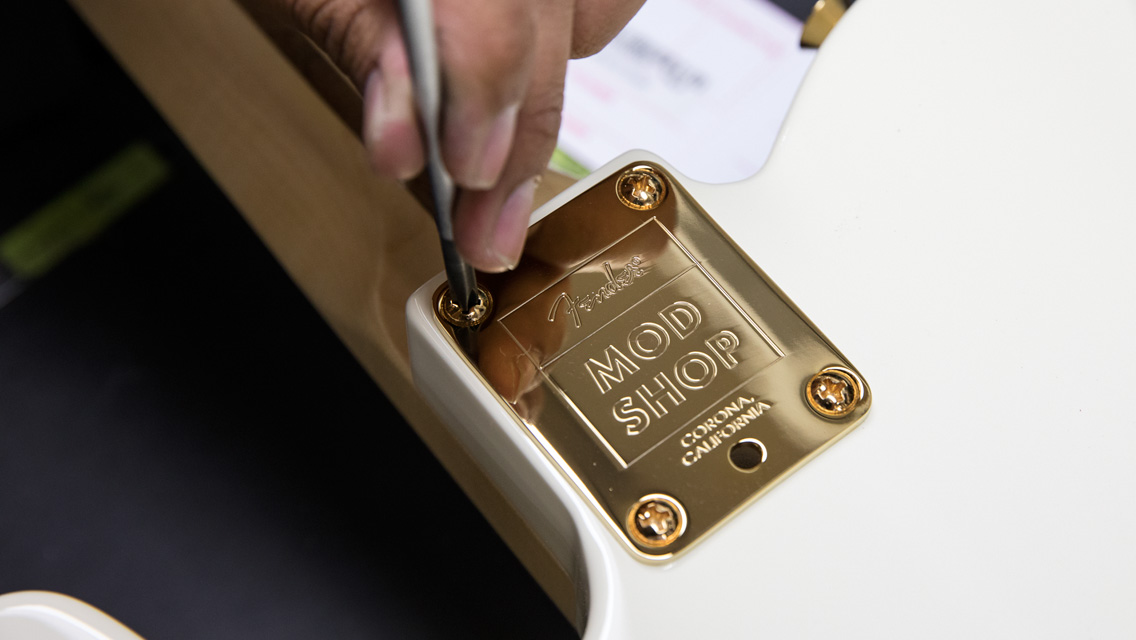By Jeff Owens
What Is a Bi-Flex Truss Rod and How Does It Work?
Get the inside scoop on Fender's innovative truss rod system.

What exactly is the Bi-Flex truss rod, and what does it do?
Do all Fender guitars have it?
Do Fender basses have it?
Does it consist of two rods, as some suppose?
Is it the same thing as a "dual-action" truss rod, which is another term players are bound to come across?
There seems to be some confusion online and out there in the real world regarding the Bi-Flex truss rod-what it does and how it works. These questions and subsequent answers should straighten everything out.
What Is a Bi-Flex Truss Rod?
It's a special truss rod, or truss rod system if you like, developed and first used by Fender in the early 1980s. It has remained in use ever since on a relatively small number of electric guitars. Today, Bi-Flex truss rods are found in American Professional models.
What Does a Bi-Flex Truss Rod Do?
Truss rods have been around for decades; in fact, pretty much ever since the early-1900s advent of steel guitar strings, which exert considerably more bending force on wooden guitar necks than nylon and gut strings. A truss rod compensates for this immense bending force by mechanically producing a force that counteracts it.
Most electric guitars have what's called a single-action truss rod, which consists of a single rod set into a channel routed into the center of the neck down its length. The rod is anchored at one end of the neck and has an accessible adjustment mechanism at the other end typically consisting of a nut that can be turned using a screwdriver or Allen wrench.
It's called a single-action truss rod because it works in one direction only. That is, tightening it straightens undue concave neck bowing-dipping toward the center of the neck, in other words (we say undue because a very slight amount of concave neck bow-or relief-is actually optimal on most guitars). But that's all it does; it doesn't work in the opposite direction.
The Bi-Flex truss rod is still a single rod, but it works in both directions. It can correct concave neck bowing just as a single-action truss rod does, but it can also be adjusted in the opposite direction to correct convex neck bowing.
Tightening a Bi-Flex truss rod by turning the nut clockwise straightens concave neck curvature by bowing the neck backward. When turning the nut counterclockwise, however, you'll first run across a "neutral position" in which the mechanism isn't applying force in either direction, and then you will encounter renewed tightening as the rod pushes against a walnut dowel near the nut, bowing the neck bow forward and thus correcting convex or "humped" neck relief.
Incidentally, this means that the Bi-Flex truss rod is capable of coming perilously close to the back of the neck in the area of the seventh fret-as near as 1/8" inch from the outside world. When the system was being devised and tested back in the early 1980s, in fact, the force could become so great in the area of that very short distance that wood failure actually occurred in some cases and truss rods actually blew right through the back of some test necks (which must have been pretty cool to see). Fender designers remedied this situation by setting a small truss rod retainer fitting into the neck just beneath the seventh-fret fingerboard inlay (you can see the screw that holds it in place if you pop out the inlay). The Bi-Flex truss rod passes straight through this unseen retainer, which keeps the rod securely in place and helps transfer the corrective force to the areas of the neck flanking its middle. Problem solved.
Do All Fender Guitars Have Bi-Flex Truss Rods?
No, just some. As noted, Bi-Flex truss rods are currently offered in American Professional guitars. Other Fender guitar models, such as the Highway One series of 2002-2011, have truss rods that resemble but are not in fact Bi-Flex truss rods.
Do Any Current Basses Have Bi-Flex Truss Rods?
Nope. Just certain guitars.
They used to, though. From 1982 to 1984 and from 1989 to 1995, U.S.-made Fender basses did have Bi-Flex truss rods. But since basses rarely need counterclockwise truss rod adjustment, more powerful single-action truss rods with a larger diameter replaced Bi-Flex truss rods in Fender basses.
A Bi-Flex Truss Rod Doesn't Consist of Two Rods, Then?
No, it doesn't. There's only one rod. There are "dual-action" truss rods that do in fact consist of double rods, but the Bi-Flex system uses only a single truss rod. The "Bi" part of the name has undoubtedly caused some confusion here, but it refers to the mechanism working in two directions, not being designed with double rods.
Is a Bi-Flex Truss Rod the Same Thing as a 'Dual-Action' Truss Rod?
Not really but maybe kind of, sort of. There is an understanding that the phrase "dual-action" truss rod is frequently used to refer to truss rod systems that actually use two rods. That said, it's possible that this is something of a semantic gray area here, as Fender's Bi-Flex truss rod can indeed be sensibly described as providing dual actions-force in one direction and force in the opposite direction. We wouldn't get too worked up about it, though; suffice to say that a Bi-Flex truss rod is a single truss rod that efficiently provides useful corrective force for both concave and convex neck bowing.
Don’t miss out!
Be the first to know about new products, featured content, exclusive offers and giveaways.


